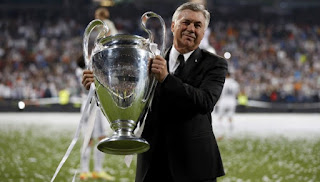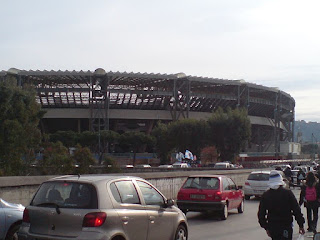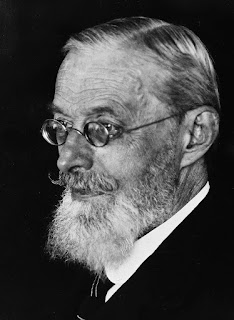Four-times winner of the Champions League
 |
| Carlo Ancelotti in the Milan colours in which he twice won European football's top prize as both a player and a manager |
With Real Madrid's defeat of Liverpool in the 2022 final, he became the only manager to have won the UEFA Champions League four times - twice with AC Milan and twice with Real Madrid. He is also the only coach to have managed teams in five finals.
Ancelotti, who has managed title-winning teams in four countries, is also one of only seven to have won the European Cup or Champions League as a player and gone on to do so as a manager too.
As a boy, Ancelotti often helped his father, Giuseppe, who made and sold cheese for a living, in the fields on the family farm, which is where he claims he acquired his appreciation of hard work.
But despite the cheeses of Emilia-Romagna having international renown, especially the famous Parmigiana-Reggiano, he saw how his father struggled to make enough money to feed his family and vowed to make more of his own life.
 |
| Ancelotti is one of the most accomplished coaches in world football |
After playing for his local youth team in Reggiolo, Ancelotti was snapped up as a teenager by Parma, making his debut in Serie C - the third tier in Italian football - in the 1976–77 season, at the age of 18. His two goals in the decisive play-off earned the gialloblu promotion to Serie B the following year.
He joined Roma in 1979, staying in the capital for eight trophy-laden seasons, winning the Coppa Italia four times and his first Serie A title in 1983, under the great Swedish coach Nils Liedholm.
Then came six seasons with Arrigo Sacchi’s magnificent AC Milan team, which won the Scudetto - the Serie A title - in 1988, and the European Cup in both 1989 and 1990. He won his third Scudetto when Fabio Capello replaced Sacchi as manager.
An efficient and assiduous midfield player, he could create goals and score them, which earned him a place in the Italian national team, although injuries restricted him to 26 senior caps and caused him to miss the 1982 and 1986 World Cups as well as the Olympics in Seoul in 1988. He did win a bronze medal as part of the Azzurri squad at the 1990 World Cup on home soil.
As a mentor to several future top-class players, including Giuseppe Giannini, Demetrio Albertini and Andrea Pirlo, Ancelotti displayed burgeoning man-management skills even while still a player.
 |
| Ancelotti with the Champions League trophy after winning it for the third time with Real Madrid in 2014 |
Ancelotti stepped on to the club management ladder in familiar territory with Reggiana in Serie B in 1995. He had to wait seven years for his first major trophy, but claimed the biggest prize first as AC Milan, his fourth club after Reggiana, Parma and Juventus, won the 2002-03 Champions League final, defeating Juventus in the final on penalties.
Now major trophies came thick and fast: a Serie A title with Milan in 2004 and a second Champions League in 2007, when victory over Liverpool in the final in Athens made up for the catastrophe of losing the 2005 final to the same opponents in Istanbul after being 3-0 up at half-time.
 |
| The Stadio San Paolo in Naples, where Ancelotti takes up his next management position in July |
After taking some time off for a back operation, Ancelotti resurfaced at Bayern Munich, where he succeeded Pep Guardiola and led the German giants to their fifth consecutive Bundesliga title. But lack of success in the Champions League led to his dismissal in September 2017.
He later had spells with Napoli back in Italy and Everton in England, before returning to Real Madrid in 2021.
Having been with his first wife, Luisa, for 25 years before they divorced in 2008, Ancelotti is now married to the Canadian businesswoman Barrena McClay, whom he met while they were both working in London. He has two children, Katia and Davide, from his first marriage. Davide was on his father’s coaching staff at Bayern Munich.
(Updated on 09-06-22)
Travel tip:
Ancelotti’s home town of Reggiolo is close to the border of Emilia-Romagna and Veneto, about 32km (20 miles) north of Reggio Emilia in the Padana plain. It is the same distance from Mantua in the Veneto and was the frequent target of attacks between the 12th and 14th centuries, when Mantua and Reggio disputed possession. This led to the construction of the impressive walled castle that remains the town’s main feature.
Travel tip:
Although the city of Reggio Emilia is often described as the home of Italy's world famous hard cheese, Parmigiano-Reggiano - known in English as Parmesan - is thought to have originated in the commune of Bibbiano, in the Reggio Emilia province, about 15km (9 miles) to the southeast. The province is also believed to have given Italy its tricolore national flag, with evidence that a short-lived 18th century republic, the Repubblica Cispadana, had a flag of red, white and green. The city lacks the cultural wealth of neighbouring Parma and is consequently less visited but it has an attractive historic centre with a number of notable buildings, including the Basilica della Ghiara and the 10th century Basilica di San Prospero, which overlooks the elegant Piazza of the same name.
More reading:
How Arrigo Sacchi started a tactical and technical revolution in Italian football
The genius of Andrea Pirlo
Coaching veteran Fabio Capello has won Serie A five times
Also on this day:
1918: The death of writer and composer Arrigo Boito
1940: Italy enters the Second World War
Home
| The Rocca di Reggiolo in Ancelotti's home town |
Ancelotti’s home town of Reggiolo is close to the border of Emilia-Romagna and Veneto, about 32km (20 miles) north of Reggio Emilia in the Padana plain. It is the same distance from Mantua in the Veneto and was the frequent target of attacks between the 12th and 14th centuries, when Mantua and Reggio disputed possession. This led to the construction of the impressive walled castle that remains the town’s main feature.
 |
| Piazza San Prospero in Reggio Emilia often hosts a market |
Although the city of Reggio Emilia is often described as the home of Italy's world famous hard cheese, Parmigiano-Reggiano - known in English as Parmesan - is thought to have originated in the commune of Bibbiano, in the Reggio Emilia province, about 15km (9 miles) to the southeast. The province is also believed to have given Italy its tricolore national flag, with evidence that a short-lived 18th century republic, the Repubblica Cispadana, had a flag of red, white and green. The city lacks the cultural wealth of neighbouring Parma and is consequently less visited but it has an attractive historic centre with a number of notable buildings, including the Basilica della Ghiara and the 10th century Basilica di San Prospero, which overlooks the elegant Piazza of the same name.
More reading:
How Arrigo Sacchi started a tactical and technical revolution in Italian football
The genius of Andrea Pirlo
Coaching veteran Fabio Capello has won Serie A five times
Also on this day:
1918: The death of writer and composer Arrigo Boito
1940: Italy enters the Second World War
Home








